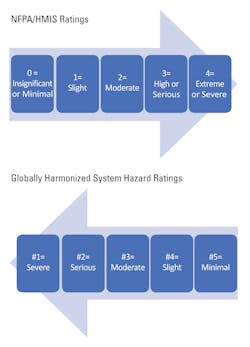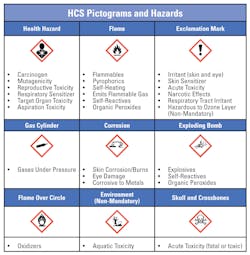Chemical management in today’s laboratory
When it comes to the management of chemicals in today’s laboratories, there are two main sets of regulations to consider, both of which have been set by the Occupational Safety and Health Administration (OSHA). These rules for handling chemicals are sometimes complicated, and they don’t always provide clear answers for some of the issues you might run into during the course of day-to-day laboratory management. There are ways to make the interpretation of the regulations easier, however, there may be other resources to consider when making decisions about chemical handling and storage.
OSHA standards
The first standard that applies to laboratories using chemicals is the Hazard Communication (HazCom) Standard (29 CFR 1910.1200). These regulations apply to any employer that manufactures, distributes, or receives hazardous chemicals. The HazCom directives require that these chemicals are properly labeled, that Safety Data Sheets are available, and that employees are made aware of the hazards associated with the inventory of chemicals maintained and used on-site. The HazCom standard was originally promulgated in 1987, but a major revision in 2012 (to align with the Globally Harmonized System (GHS)) affected how every chemical must be classified and labeled.
The other OSHA standard that guides lab chemical management is the Chemical Hygiene standard, also known as the Lab standard (29 CFR 1910.1450). This set of chemical regulations from 1990 is specific for laboratories, and it supersedes HazCom statutes. OSHA realized labs have specific methods for chemical handling that the HazCom standard did not cover, so this newer rule contains guidance which speaks to a written chemical hygiene plan, lab chemical exposure, and training.
While these two standards provide a great deal of guidance for laboratories, they do not provide all of the information necessary for a complete chemical management program in the lab, and this particular lab safety topic tends to conjure more questions than any other for lab safety professionals. Because of that, it is important to look at other regulations as well. Laboratory accreditation agencies such as the College of American Pathologists (CAP) and others create standards around chemical management which must be considered—OSHA is not the only resource referenced in those standards.
The National Fire Protection Association (NFPA) is an international nonprofit agency of members and volunteers that creates fire safety standards. If a regulatory body refers to or incorporates wording from the NFPA, then complying with the standards becomes mandatory. One NFPA standard, Standard 45: Standard on Fire Protection for Laboratories Using Chemicals, contains guidelines that pertain to flammable chemical handling that must be followed in most laboratories. Other written guidance that can affect lab chemical management includes the International Fire code (IFC), and safety documents from Clinical and Laboratory Standards Institute (CLSI).
Labeling
The conversion to a new chemical labeling convention that came with the advent of the GHS in 2012 created a fairly clear path for chemical manufacturers. All primary chemical containers needed new specific label elements such as a signal word, a hazard statement, and appropriate pictograms. These updated labels were required by a specific deadline, which was difficult for some chemical manufacturers, but the direction was clear.
What was not as clear, was how laboratories were to handle secondary container labeling. Secondary or pour-off chemical containers require some sort of hazard warning as well, and many labs were using the NFPA diamond to accomplish that. Other labs were using the Hazardous Materials Identification System (HMIS) rating system. Confusion arose because the new HazCom standard created a new rating system that did not match the two that were already in use. The GHS hazard ratings scale was the opposite of what many users had experienced (Figure 1).
OSHA helped to clarify the confusion by pointing out that the updated HazCom standard did not require that the new GHS rating system be displayed on chemical container labels. That meant chemical manufacturers’ primary container labels would not display a numerical rating, but it also meant that laboratories could continue to use NFPA or HMIS conventions for labeling secondary chemical containers. While some laboratories have converted to GHS labeling for all containers, many still use the older conventions as well. No matter what type of hazard warning is used, OSHA does require that laboratory policies and training peak to it specifically.
Classification of chemical mixtures
Standardized chemical hazard classification was another goal of the updated HazCom standard. The use of the newly introduced pictograms became an easy way for users to know whether or not a chemical was hazardous, and which types of hazards were present (Figure 2). New standardized Safety Data Sheets (SDS) were another tool laboratories had that would help provide information regarding chemical risk, and the pictograms appear on chemical labels and on the SDS. But again, these changes brought some uncertainty.
Section two of each Safety Data Sheet is where the chemical Hazard Identification and appropriate pictograms are located. However, on a SDS for a reagent that is a mixture of chemicals, there are other pictograms for each component chemical of that mixture in section three, and they may not match the pictograms seen in section two. Given that, laboratorians may become confused about which pictograms to use on a secondary container label or on a chemical inventory form.
In the case of mixtures or solutions, it is important to know that the hazards of the final solution—those identified in section two of the SDS—are those which identify which hazard and warning symbol are needed for that mixture of chemicals. Chemical mixture manufacturers have listed the data from the individual raw components on the SDS, but it may be that with dilutions or other processes used in making the final product, that those hazards listed in section three are minimized. Lab employees only need to be concerned about the hazard warnings of the final product in section two.
Chemical storage
The NFPA 45 standard limits the amount of flammable chemicals that can be stored in a lab area. The amount of allowable storage varies based on whether or not the chemicals are kept in safety cans and if there is an automated sprinkler system in place in the laboratory. Because of the limitations, the use of flammable cabinets is common in labs in order to safely store excess flammable chemicals. However, many safety professionals are not aware of the regulations that could affect the type of cabinets that should be used.
The International Fire Code (IFC) is a model code that presents minimum fire safety guidelines for buildings, facilities, storage, and processes. The adoption of the code and any associated regulations occurs at the state level. Currently, the latest version of the IFC (2018) has been adopted in 42 U.S. states.
Chapter 57 of the International Fire Code, Flammable and Combustible Liquids, contains information pertinent to laboratories that store flammable chemicals. The code states that flammable liquid storage cabinets must have doors well fitted, self-closing, and equipped with a three-point latch. This is not a widely-known standard, and many laboratories across the country use flammable cabinets that do not have self-closing doors. Possible solutions include purchasing self-closing door adapters or replacing the cabinets.
Other laboratory flammable storage regulations come from the NFPA 45 standard. The regulation requires that refrigerators or freezers in the lab that are used to store flammable material must be rated as explosion-proof. They need to be designed so that there is no risk of sparks from motors or lights. The regulation further requires that all lab cold storage units are labeled as to their capacity to store flammable materials. That means that even if your laboratory does not have explosion-proof units and you do not store flammable materials, the refrigerators and freezers still need to be labeled with signage that warns to prevent such storage.
Chemical management questions and answers
Chemical management in the laboratory is a vast safety subject matter, and the resources that regulate it are many. If you’re putting together a chemical hygiene plan for the first time, there are model plans offered by OSHA and other agencies. Read the standards from your lab’s accrediting bodies and make sure the lab complies with them. Continue reading articles and reach out to experts with questions if something remains unclear. Handling hazardous chemicals can be a dangerous process in the lab setting, but with a proper management plan in place and adequate staff training, safety can be attained for all who store and utilize those chemicals.


